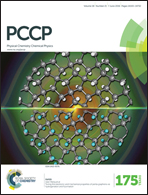Electronic structure of p-type perylene monoimide-based donor–acceptor dyes on the nickel oxide (100) surface: a DFT approach†
Abstract
A p-type dye-sensitized solar cell, where the dye injects a hole into the semiconductor, could be combined with a typical Grätzel cell to create an efficient tandem device. However, the current p-type devices suffer from low efficiency. Here, geometries and electronic structures of four perylenemonoimide-based dyes (1–4) both as free and adsorbed on the NiO(100) semiconductor surface have been investigated to gain a better understanding of the p-type devices. In particular, the electronic transitions relevant to charge transfer between the dye and the surface have been identified. Excitations have been evaluated using the time-dependent DFT calculations, and the roles of frontier orbitals and band edges in transitions have been assessed. The adsorbed dyes can adopt either upright or slightly tilted geometries depending on the structure of the anchoring group and the binding mode of the dye. The adsorption slightly lowers the NiO band gap, from 4.06 eV to 3.90–3.96 eV, depending on the surface–adsorbate system and the band gaps of the dye molecules by 0.1–0.2 eV. Additionally, the adsorption mode of dye 1 moves the LUMO+1 level down by 0.5 eV. The effective mass of charge carrier holes is significantly smaller at the NiO surface than in the bulk indicating the importance of surface conductivity. We also found that the potential drop, i.e. the driving force for charge transfer from NiO to the dye molecule, depends on the adsorption mode of 1.



 Please wait while we load your content...
Please wait while we load your content...